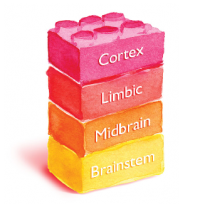
The brain develops from the bottom up, like a stack of building blocks. The lower building blocks, the brainstem and the mid-brain, are the first areas of the brain to develop and connect. These areas are often referred to as the ‘survival brain’ because they control basic body functions, such as regulating blood pressure and body temperature. The upper building blocks, the limbic system and the cerebral cortex, are referred to as the ‘intellectual’ or thinking brain.
The limbic system is the emotional core of the brain. The cortex forms an outer covering around the brain that accounts for 85 percent of the human brain mass. The cortex is where reason, logic, and rational thinking originate. Reading, writing, and arithmetic are cortical functions. During adolescence, the cortex goes through a major period of growth and change that helps adolescents transition into adulthood.
The portion of the cortex that is located right behind the forehead is called the prefrontal cortex. Often called the CEO of the brain, the prefrontal cortex is one of the last areas of the brain to mature. A mature prefrontal cortex is necessary for good judgment, controlling impulses, solving problems, setting goals, organizing and planning, and other skills that are essential to adults. Following a growth spurt that occurs around age 9 or 10, when the prefrontal cortex actually thickens, this area of the brain goes through a pruning process that starts around age 11 and continues into early adulthood.
New experiences will stimulate more brain connections and new neural pathways. Connections that are not used will be eliminated. The human brain also gets its final layer of insulation during adolescence. Myelin, a fatty substance, is deposited on critical brain connections. Myelination increases the speed with which electrical and chemical messages are transmitted throughout the brain. The prefrontal cortex is the last area of the brain to complete myelination.
Changes in the adolescent brain are not limited to the cortex. One of the other regions of the brain that is going through a metamorphosis during adolescence and that is particularly shaped by environment and experience is the cerebellum. The cerebellum not only coordinates certain types of movement but also acts as a support system for other cognitive functions, such as recognizing social cues. The cerebellum, which has more neurons than any other place in the brain and which continues to grow into the early twenties, appears to be the last area of the brain to mature.
As teens mature, their brains become faster, sharper, and more specialized. They begin to: develop advanced reasoning abilities; expand their capacity for abstract and critical thinking; understand ‘how’ and ‘why’ questions; analyze complex issues; and evaluate alternatives before making a decision. Although teens have an amazing capacity for learning and memorizing new information, they often experience difficulty with prefrontal cortex functions, such as prioritizing what is important and organizing tasks. Teens need guidance from adults as they develop these skills.
Teachers and healthcare providers can do a number of things to help teens while the prefrontal cortex is still developing:
-
• Give teens simple instructions, both verbally and in writing. Avoid asking a teen to multi-
task. (For example, avoid: “Read two chapters; write a brief response; don’t forget to
study for your unit test; and have your parents sign the permission slip for the field
trip.”) Avoid giving complex directions. (For example, avoid: “Take the first prescription
three times a day – two pills each time, on an empty stomach, and for 10 days. Then
take the second prescription, right before bed, for 14 days.”) Being asked to multi-task
or to follow complex directions can overwhelm an adolescent whose brain is just
learning how to sort and prioritize. -
• Help teens create systems to manage their time, organize tasks, and identify priorities.
Teachers can encourage teens to use calendars and planners to organize homework and
testing schedules. Healthcare providers can give teens appointment cards and make
phone calls or send text messages to remind teens of upcoming appointments. -
• Provide many, varied opportunities for teens to get involved in new hobbies and to
discover their own interests, passions, and talents. The teenage brain needs lots of
stimulation. So, be sure that teens have access to a wide range of learning opportunities,
both in and out of the classroom. Activities should include: music, drama, photography,
and other arts; dance, games, physical education, and sports; and outdoor recreation as
well as classroom education. -
• Use active learning methods to encourage teens to develop their skills. For example, use
interactive exercises, such as role-plays, values clarification exercises, and forced choice
scenarios. These teach teens to make decisions, be assertive, negotiate, prioritize, and
set goals. Provide opportunities for hands-on experiences. Give teens concrete
examples, since they are still developing their capacity for abstract thinking. Healthcare
providers and educators can use visual aids, websites, computer-assisted tools, and
clearly written materials to teach teens about health topics.

